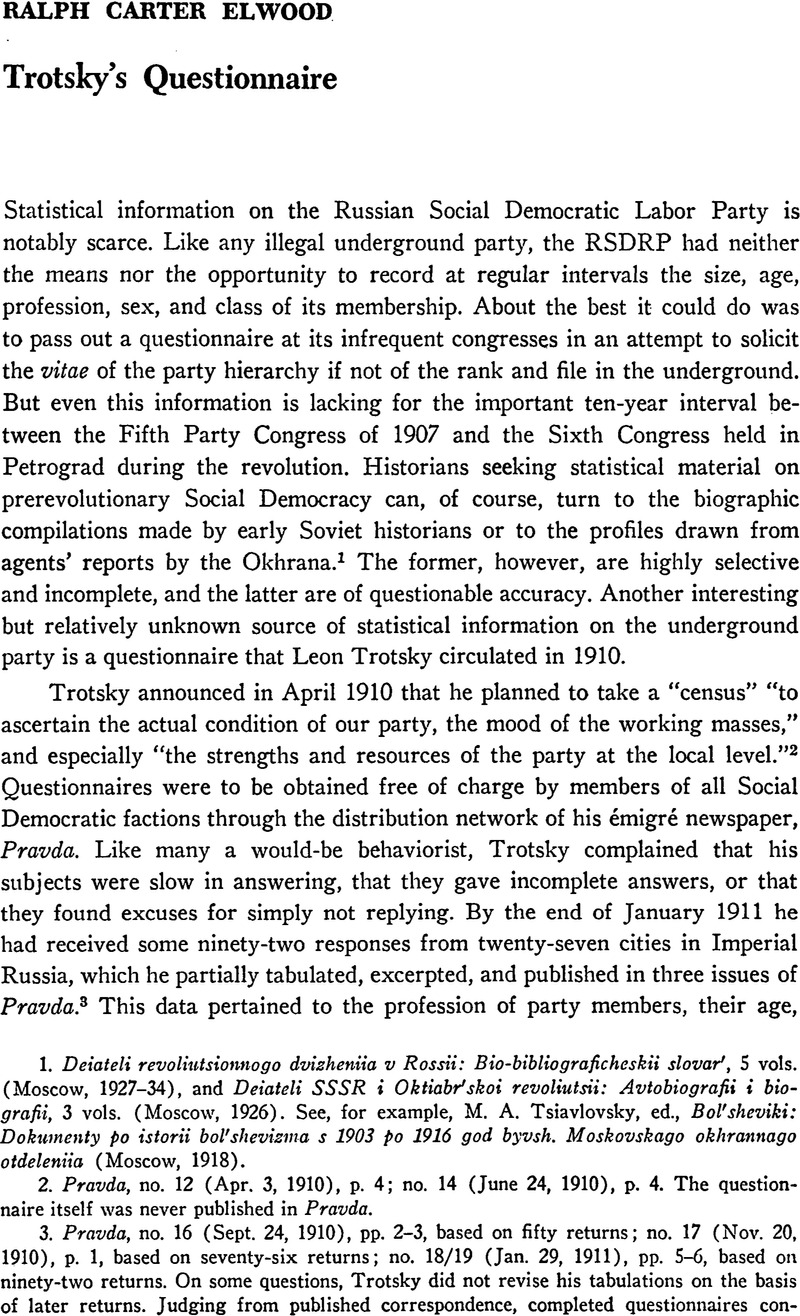No CrossRef data available.
Published online by Cambridge University Press: 27 January 2017

1. Deiateli revoliutsionnogo dvizheniia v Rossii : Bio-bibliograficheskii slovar', 5 vols. (Moscow, 1927-34), and Deiateli SSSR i Oktiabr'skoi revoliutsii : Avtobiografii i biografii, 3 vols. (Moscow, 1926). See, for example, Tsiavlovsky, M. A., ed., Bol'sheviki : Dokumenty po istorii bol'shevisma s 1903 po 1916 god byvsh. Moskovskago okhrannago otdeleniia (Moscow, 1918).Google Scholar
2. Pravda, no. 12 (Apr. 3, 1910), p. 4; no. 14 (June 24, 1910), p. 4. The questionnaire itself was never published in Pravda.
3. Pravda, no. 16 (Sept. 24, 1910), pp. 2-3, based on fifty returns; no. 17 (Nov. 20, 1910), p. 1, based on seventy-six returns; no. 18/19 (Jan. 29, 1911), pp. 5-6, based on ninety-two returns. On some questions, Trotsky did not revise his tabulations on the basis of later returns. Judging from published correspondence, completed questionnaires continued to filter in throughout 1911, but these also were never summarized. It is unfortunate that Trotsky chose not to publish the ten autobiographical essays on “How I Became a Social Democrat” which he received in connection with the questionnaire.
4. Keep, J. L. H., The Rise of Social Democracy in Russia (Oxford, 1963), p. 117.Google Scholar
5. Institut Marksizma-Leninizma pri TsK KPSS, Chetvertyi (ob“edinitel'nyi) s“ezd RSDRP, aprel (aprel-mai) 1906 goda : Protokoly (hereafter abbreviated Prot. IV) (Moscow, 1959), p. 459. Idem, , Piatyi (Londonskii) s“ezd RSDRP, aprel-mai 1907 goda : Protokoly (Moscow, 1963), p. 656.Google Scholar
6. Tsiavlovsky, Bol'sheviki, pp. 86-89.
7. See the correspondence from various Ukrainian organizations to Pravda, no. 11 (Mar. 18, 1910), p. 4; no. 14, p. 4; no. 16, pp. 3-4. Proletarii, no. 18 (Oct. 29, 1907), p. 7; no. 40 (Dec. 1, 1908), p. 7. Golos Sotsial-demokrata, no. 19/20 (January/February 1910), p. 30.
8. Institut Marksizma-Leninizma pri TsK KPSS, Vtoroi s“e2d RSDRP, iiul-avgnst 1903 goda : Protokoly (Moscow, 1959), pp. 801-25; Tretii s“esd RSDRP, aprel-mai 1905 goda : Protokoly (Moscow, 1959), pp. 730-50; Prot. V, p. 658.
9. Prot. II, pp. 801-25; Prot. III, pp. 730-50; Prot. IV, p. 459; Prot. V, p. 658.
10. One might also note (by subtracting the average length of party membership from the average age) that workers were joining the RSDRP at an increasingly earlier age. At the Second Congress the average age at which the delegates joined the party was 23.2; at the Fifth Congress, 21.6; for the respondents of the questionnaire, 19 years of age.
11. A recent Soviet compilation of leaflets printed in the Ukraine, for example, contains thirty-nine proclamations for 1908 but only five for 1911 : Institut istorii partii TsK KP Ukrainy, Bol'sheviki Ukrainy v period meshdu pervoi i vtoroi burshtiasnodemokraticheskimi revoliutsiiami v Rossii, iiun’ 1907 g.-fevral’ 1917 g. : Sbornik dokumentov i materialov (Kiev, 1960). I. G. Levitas, M. A. Moskalev, and E. M. Fingerit, Revoliutsionnye podpol'nye tipografii v Rossii, 1860-1917 gg. (Moscow, 1962), pp. 270-320. The quotation is Trotsky's conclusion as expressed in Pravda, no. 18/19, p. 2. Lenin concurred with this observation : “almost everywhere on the local level [in 1911] party groups are completely informal, extremely small, and irregularly convened, ” Leninskii sbornik, 25 (Moscow, 1933) : 86.
12. See the report of an Ekaterinoslav worker to Pravda, no. 14, p. 4.
13. Proletarii, no. 46 (July 11, 1909), p. 7.
14. Pravda, no. 24 (Mar. 14, 1912), pp. 5-6; Isveshchenie o konjerentsii organisatsii RSDRP (Vienna, 1912), pp. 10-13.
15. Pravda, no. 16, p. 2; no. 18/19, p. 5. The number of “nonfactionalists” and Bolsheviks might be somewhat misleading. The former was a term used by many of Trotsky's own followers to indicate their agreement with his strong stand against factionalism and in favor of party unity. To the die-hard Leninists, the “nonfactionalists“ in fact represented a competing faction, and therefore some Bolsheviks may have refused on principle to answer the questionnaire.
16. See also Golos Sotsial-demokrata, no. 8/9 (July/September 1908), pp. 36-37.
17. Pravda, no. 13 (May 15, 1910), pp. 2-3.
18. Pravda, no. 17, p. 1; no. 18/19, p. 5. This disinterested attitude toward the Duma is also evident in local correspondence to the other émigré newspapers. See, for instance, Prolctarii, no. 40, p. 7; Rabochaia gazeta, no. 6 (Sept. 22, 1911), p. 6; Sotsialdemokrat, no. 4 (Mar. 21, 1909), p. 8, and no. 12 (Mar. 23, 1910), p. 10.
19. See Leopold, Haimson, “The Problem of Social Stability in Urban Russia, 1905— 1917,” Slavic Revieiv, 23, no. 4 (December 1964) : 619–42Google Scholar; 24, no. 1 (March 1965) : 1-22; and subsequent Forum discussion.